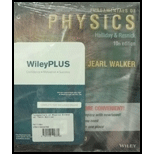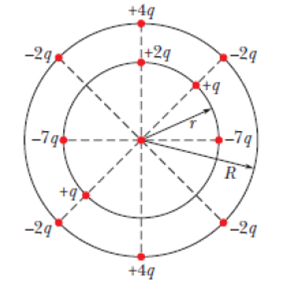
Fundamentals of Physics Extended 10e Binder Ready Version + WileyPLUS Registration Card
10th Edition
ISBN: 9781118732090
Author: David Halliday
Publisher: Wiley (WileyPLUS Products)
expand_more
expand_more
format_list_bulleted
Concept explainers
Textbook Question
Chapter 21, Problem 5Q
In Fig. 21-15, a central particle of charge −q is surrounded by two circular rings of charged particles. What are the magnitude and direction of the net electrostatic force on the central particle due to the other particles? (Hint: Consider symmetry.)

Figure 21-15 Question 5.
Expert Solution & Answer
Want to see the full answer?
Check out a sample textbook solution
Students have asked these similar questions
!
Required information
The radius of the Moon is 1.737 Mm and the distance between Earth and the Moon is 384.5 Mm.
The intensity of the moonlight incident on her eye is 0.0220 W/m². What is the intensity incident on her retina if the
diameter of her pupil is 6.54 mm and the diameter of her eye is 1.94 cm?
W/m²
Required information
An object is placed 20.0 cm from a converging lens with focal length 15.0 cm (see the figure, not drawn to scale). A
concave mirror with focal length 10.0 cm is located 76.5 cm to the right of the lens. Light goes through the lens, reflects
from the mirror, and passes through the lens again, forming a final image.
Converging
lens
Object
Concave
mirror
15.0 cm
-20.0 cm-
10.0 cm
d cm
d = 76.5.
What is the location of the final image?
cm to the left of the lens
!
Required information
A man requires reading glasses with +2.15-D refractive power to read a book held 40.0 cm away with a relaxed eye.
Assume the glasses are 1.90 cm from his eyes.
His uncorrected near point is 1.00 m. If one of the lenses is the one for distance vision, what should the refractive power of the other
lens (for close-up vision) in his bifocals be to give him clear vision from 25.0 cm to infinity?
2.98 D
Chapter 21 Solutions
Fundamentals of Physics Extended 10e Binder Ready Version + WileyPLUS Registration Card
Ch. 21 - Figure 21-11 shows 1 four situations in which five...Ch. 21 - Figure 21-12 shows three pairs of identical...Ch. 21 - Figure 21-13 shows four situations in which...Ch. 21 - Figure 21-14 shows two charged particles on an...Ch. 21 - In Fig. 21-15, a central particle of charge q is...Ch. 21 - A positively charged ball is brought close to an...Ch. 21 - Figure 21-16 shows three situations involving a...Ch. 21 - Figure 21-17 shows four arrangements of charged...Ch. 21 - Figure 21-18 shows four situations in which...Ch. 21 - In Fig. 21-19, a central particle of charge 2q is...
Ch. 21 - Figure 21-20 shows three identical conducting...Ch. 21 - Figure 21-21 shows four situations in which a...Ch. 21 - SSM ILW Of the charge Q initially on a tiny...Ch. 21 - Identical isolated conducting spheres 1 and 2 have...Ch. 21 - SSM What must be the distance between point charge...Ch. 21 - In the return stroke of a typical lightning bolt,...Ch. 21 - A particle of charge 3.00 106 C is 12.0 cm...Ch. 21 - ILW Two equally chained particles are held 3.2 ...Ch. 21 - In Fig. 21-23, three charged particles lie on an x...Ch. 21 - In Fig. 21-24, three identical conducting spheres...Ch. 21 - SSM WWW Two identical conducting spheres, fixed in...Ch. 21 - GO In Fig. 21-25, four particles form a square....Ch. 21 - ILW In Fig. 21-25, the particles have charges q1 =...Ch. 21 - Two particles are fixed on an x axis. Particle 1...Ch. 21 - GO In Fig. 21-26, particle 1 of charge l.0 C and...Ch. 21 - Three particles are fixed on an x axis. Particle 1...Ch. 21 - GO The charges and coordinates of two charged...Ch. 21 - GO In Fig. 21-27a, particle l of charge q1 and...Ch. 21 - In Fig.21-28a, particles 1 and 2 have charge 20.0...Ch. 21 - In Fig. 21-29a, three positively charged particles...Ch. 21 - SSM WWW In Fig. 21-26, particle 1 of charge q and...Ch. 21 - GO Figure 21-30a shows an arrangement of three...Ch. 21 - GO A nonconducting spherical shell, with an inner...Ch. 21 - GO Figure 21-31 shows an arrangement of four...Ch. 21 - GO In Fig. 21-32, particles 1 and 2 of charge q1 =...Ch. 21 - Two tiny, spherical water drops, with identical...Ch. 21 - ILW How many electrons would have to be removed...Ch. 21 - Prob. 26PCh. 21 - SSM The magnitude of the electrostatic force...Ch. 21 - A current of 0.300 A through your chest can send...Ch. 21 - GO In Fig. 21-33, particles 2 and 4, of charge e,...Ch. 21 - In Fig. 21-26, particles 1 and 2 are fixed in...Ch. 21 - ILW Earths atmosphere is constantly bombarded by...Ch. 21 - GO Figure 21-34a shows charged particles 1 and 2...Ch. 21 - Calculate the number of coulombs of positive...Ch. 21 - GO Figure 21-35 shows electrons 1 and 2 on an x...Ch. 21 - SSM In crystals of the salt cesium chloride,...Ch. 21 - Electrons and positrons are produced by the...Ch. 21 - Prob. 37PCh. 21 - GO Figure 21-37 shows four identical conducting...Ch. 21 - SSM In Fig. 21-38, particle 1 of charge 4e is...Ch. 21 - In Fig, 21-23, particles 1 and 2 are fixed in...Ch. 21 - a What equal positive charges would have to be...Ch. 21 - In Fig. 21-39, two tiny conducting balls of...Ch. 21 - a Explain what happens to the balls of Problem 42...Ch. 21 - SSM How far apart must two protons be if the...Ch. 21 - How many megacoulombs of positive charge are in...Ch. 21 - In Fig. 21-40, four particles are fixed along an x...Ch. 21 - GO Point charges of 6.0 C and 4.0 C are placed on...Ch. 21 - In Fig. 21-41, three identical conducting spheres...Ch. 21 - A neutron consists of ore up quark of charge 2e/3...Ch. 21 - Figure 21-42 shows a long, nonconducting, massless...Ch. 21 - A charged nonconducting rod, with a length of 2.00...Ch. 21 - A particle of charge Q is Fixed at the origin of...Ch. 21 - What would be the magnitude of the electrostatic...Ch. 21 - A charge of 6.0 C is to be split into two parts...Ch. 21 - Of the charge Q on a tiny sphere, a fraction is...Ch. 21 - If a cat repeatedly rubs against your cotton...Ch. 21 - We know that the negative charge on the electron...Ch. 21 - In Fig, 21-26, particle 1 of charge 80.0C and...Ch. 21 - What is the total charge in coulombs of 75.0 kg of...Ch. 21 - GO In Fig. 21-43, six charged particles surround...Ch. 21 - Three charged particles form a triangle: particle...Ch. 21 - SSM In Fig. 21-44, what are the a magnitude and b...Ch. 21 - Two point charges of 30 nC and 40 nC are held...Ch. 21 - Two small, positively charged spheres have a...Ch. 21 - The initial charges on the three identical metal...Ch. 21 - An electron is in a vacuum near Earths surface and...Ch. 21 - SSM In Fig. 21-26, particle 1 of charge 5.00q and...Ch. 21 - Two engineering students, John with a mass of 90...Ch. 21 - In the radioactive decay of Eq. 21-13, a 238U...Ch. 21 - In Fig. 21-25, four particles form a square. The...Ch. 21 - In a spherical metal shell of radius R, an...Ch. 21 - An electron is projected with an initial speed vl...Ch. 21 - In an early model of the hydrogen atom the Bohr...Ch. 21 - A100 W lamp has a steady current of 0.83 A in its...Ch. 21 - The charges of an electron and a positron are e...
Additional Science Textbook Solutions
Find more solutions based on key concepts
3. Trails that are derived from a common ancestor, like the bones of human arms and bird wings, are said to be_...
Biological Science (6th Edition)
Compare the roles of CO2 and H2O in cellular respiration and photosynthesis.
Campbell Biology (11th Edition)
What are the functions of the hyoid bone?
Principles of Anatomy and Physiology
41. A reaction in which A, B, and C react to form products is first order in A, second order in B, and zero ord...
Chemistry: Structure and Properties (2nd Edition)
18. A small positive charge q experiences a force of magnitude F1, when placed at point 1 in Figure Q20.18. In ...
College Physics: A Strategic Approach (3rd Edition)
The bond angles in a regular polygon with n sides are equal to 180360n a. What are the bond angles in a regular...
Organic Chemistry (8th Edition)
Knowledge Booster
Learn more about
Need a deep-dive on the concept behind this application? Look no further. Learn more about this topic, physics and related others by exploring similar questions and additional content below.Similar questions
- ! Required information Assume that the magnifier is held close to the eye. Use the standard near point of 25.0 cm to find the angular magnification. An insect that is 4.10 mm long is placed 10.3 cm from a simple magnifier with a focal length of 13.0 cm. What is the angular magnification?arrow_forward2arrow_forward3arrow_forward
- Imagine you are out for a stroll on a sunny day when you encounter a lake. Unpolarized light from the sun is reflected off the lake into your eyes. However, you notice when you put on your vertically polarized sunglasses, the light reflected off the lake no longer reaches your eyes. What is the angle between the unpolarized light and the surface of the water, in degrees, measured from the horizontal? You may assume the index of refraction of air is nair=1 and the index of refraction of water is nwater=1.33 . Round your answer to three significant figures. Just enter the number, nothing else.arrow_forwardDeduce what overvoltage is like in reversible electrodes.arrow_forwardpls help on thesearrow_forward
- pls help on thesearrow_forward20. Two small conducting spheres are placed on top of insulating pads. The 3.7 × 10-10 C sphere is fixed whie the 3.0 × 107 C sphere, initially at rest, is free to move. The mass of each sphere is 0.09 kg. If the spheres are initially 0.10 m apart, how fast will the sphere be moving when they are 1.5 m apart?arrow_forwardpls help on allarrow_forward
arrow_back_ios
SEE MORE QUESTIONS
arrow_forward_ios
Recommended textbooks for you
 Principles of Physics: A Calculus-Based TextPhysicsISBN:9781133104261Author:Raymond A. Serway, John W. JewettPublisher:Cengage Learning
Principles of Physics: A Calculus-Based TextPhysicsISBN:9781133104261Author:Raymond A. Serway, John W. JewettPublisher:Cengage Learning Physics for Scientists and Engineers: Foundations...PhysicsISBN:9781133939146Author:Katz, Debora M.Publisher:Cengage Learning
Physics for Scientists and Engineers: Foundations...PhysicsISBN:9781133939146Author:Katz, Debora M.Publisher:Cengage Learning
 Physics for Scientists and Engineers, Technology ...PhysicsISBN:9781305116399Author:Raymond A. Serway, John W. JewettPublisher:Cengage Learning
Physics for Scientists and Engineers, Technology ...PhysicsISBN:9781305116399Author:Raymond A. Serway, John W. JewettPublisher:Cengage Learning Physics for Scientists and Engineers with Modern ...PhysicsISBN:9781337553292Author:Raymond A. Serway, John W. JewettPublisher:Cengage Learning
Physics for Scientists and Engineers with Modern ...PhysicsISBN:9781337553292Author:Raymond A. Serway, John W. JewettPublisher:Cengage Learning Physics for Scientists and EngineersPhysicsISBN:9781337553278Author:Raymond A. Serway, John W. JewettPublisher:Cengage Learning
Physics for Scientists and EngineersPhysicsISBN:9781337553278Author:Raymond A. Serway, John W. JewettPublisher:Cengage Learning

Principles of Physics: A Calculus-Based Text
Physics
ISBN:9781133104261
Author:Raymond A. Serway, John W. Jewett
Publisher:Cengage Learning

Physics for Scientists and Engineers: Foundations...
Physics
ISBN:9781133939146
Author:Katz, Debora M.
Publisher:Cengage Learning


Physics for Scientists and Engineers, Technology ...
Physics
ISBN:9781305116399
Author:Raymond A. Serway, John W. Jewett
Publisher:Cengage Learning

Physics for Scientists and Engineers with Modern ...
Physics
ISBN:9781337553292
Author:Raymond A. Serway, John W. Jewett
Publisher:Cengage Learning

Physics for Scientists and Engineers
Physics
ISBN:9781337553278
Author:Raymond A. Serway, John W. Jewett
Publisher:Cengage Learning
Electric Fields: Crash Course Physics #26; Author: CrashCourse;https://www.youtube.com/watch?v=mdulzEfQXDE;License: Standard YouTube License, CC-BY